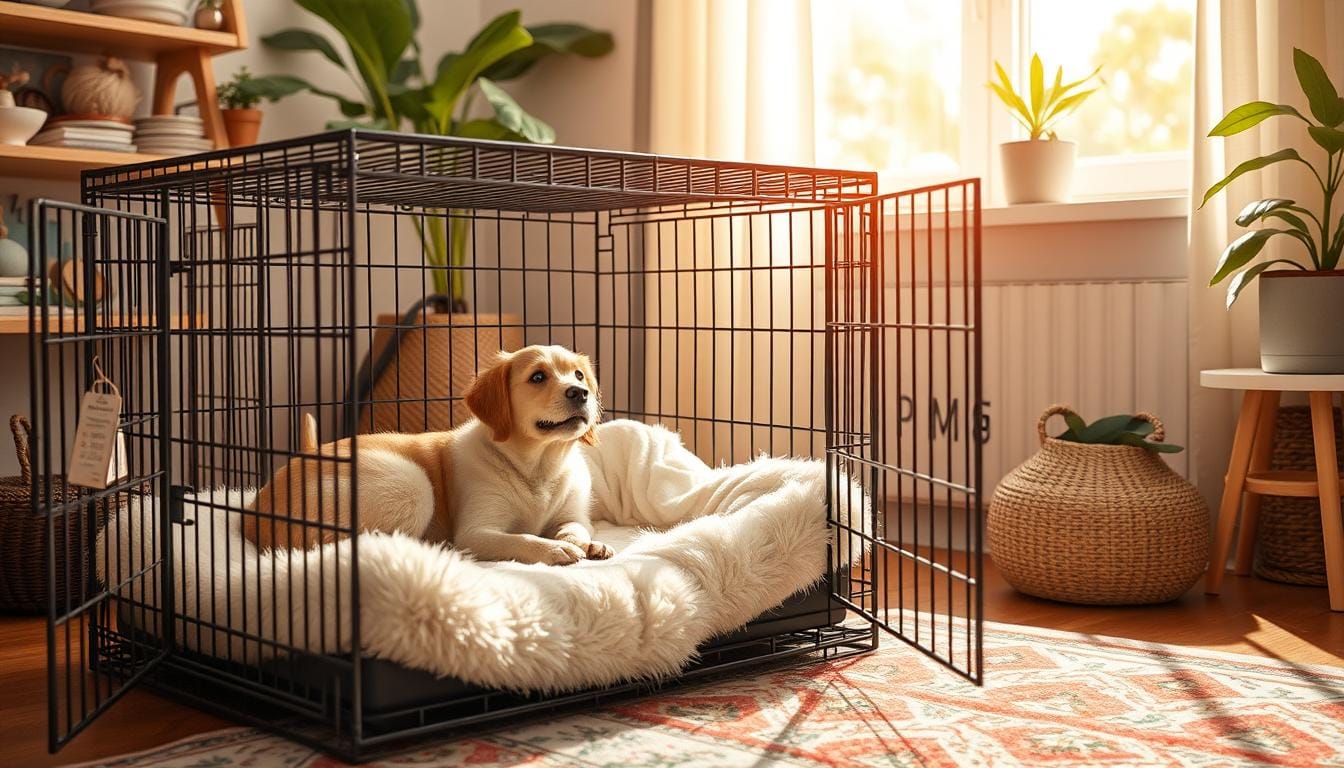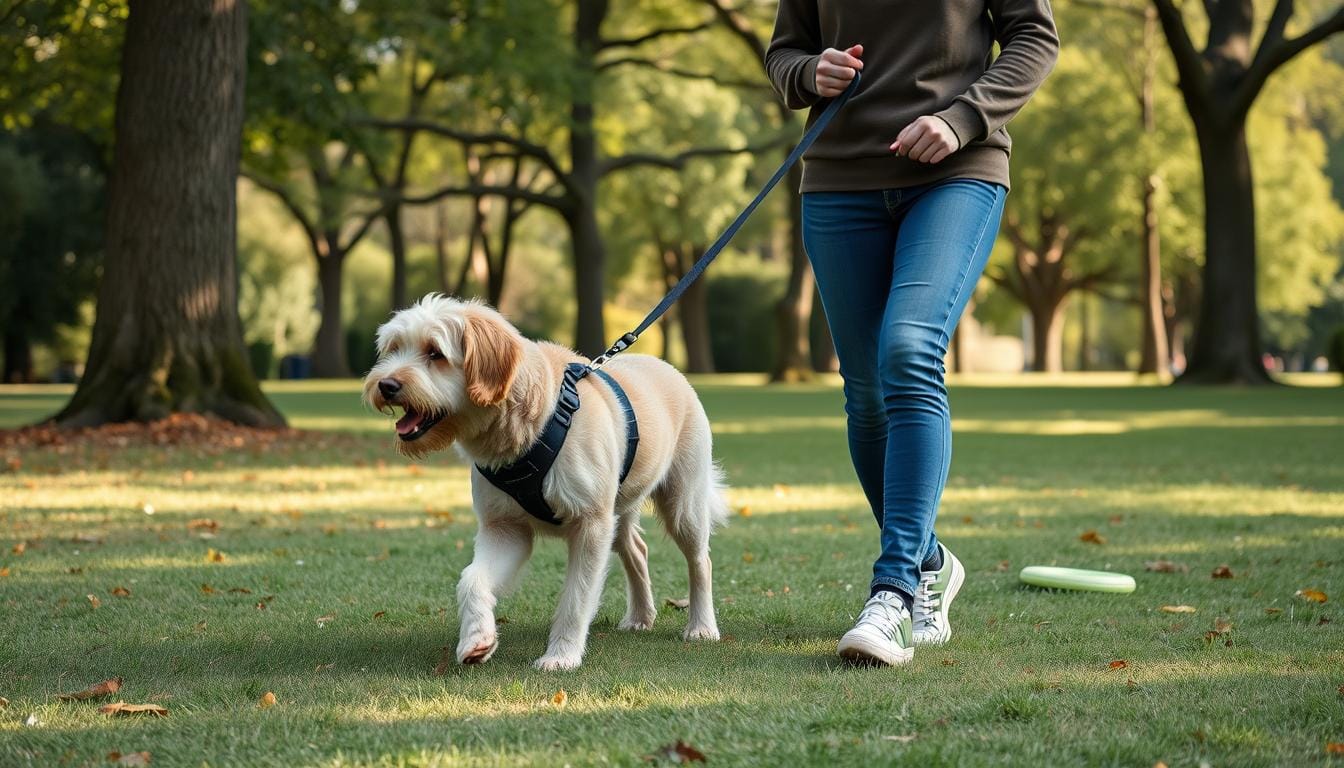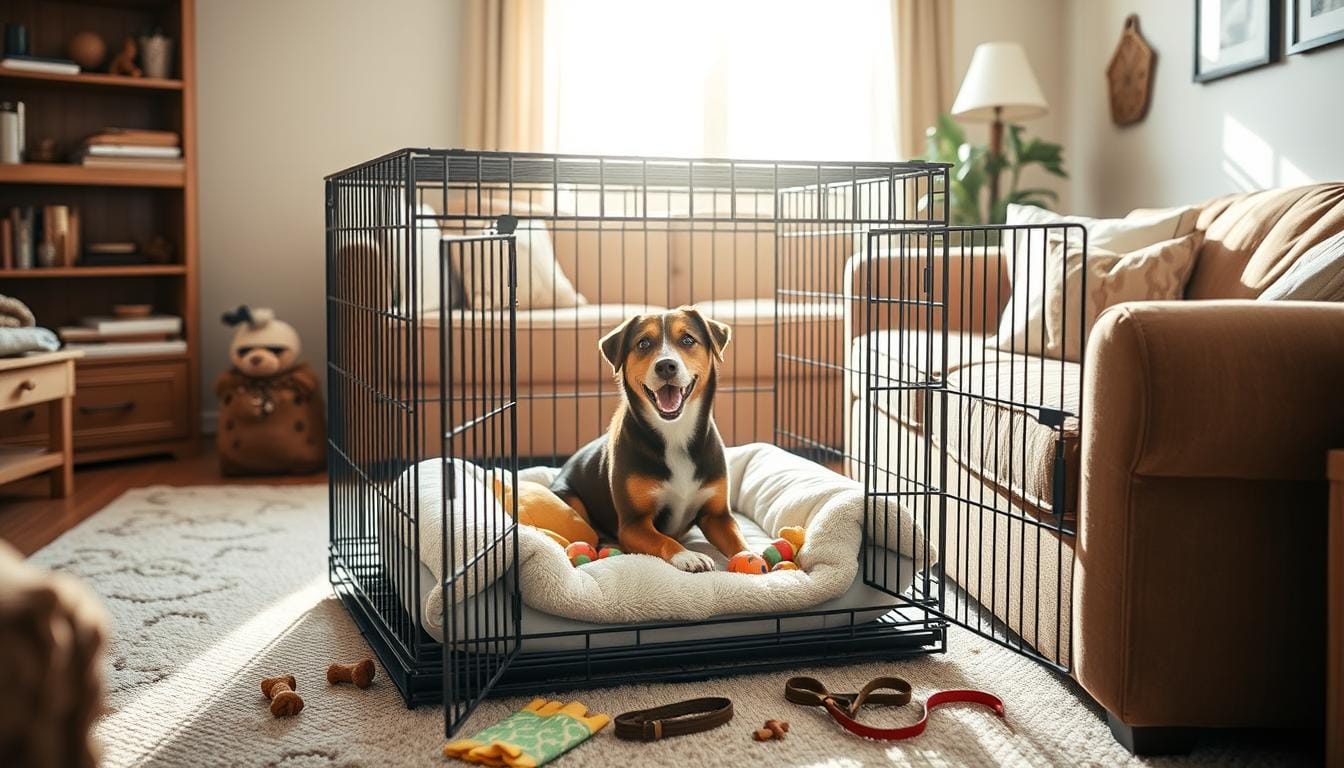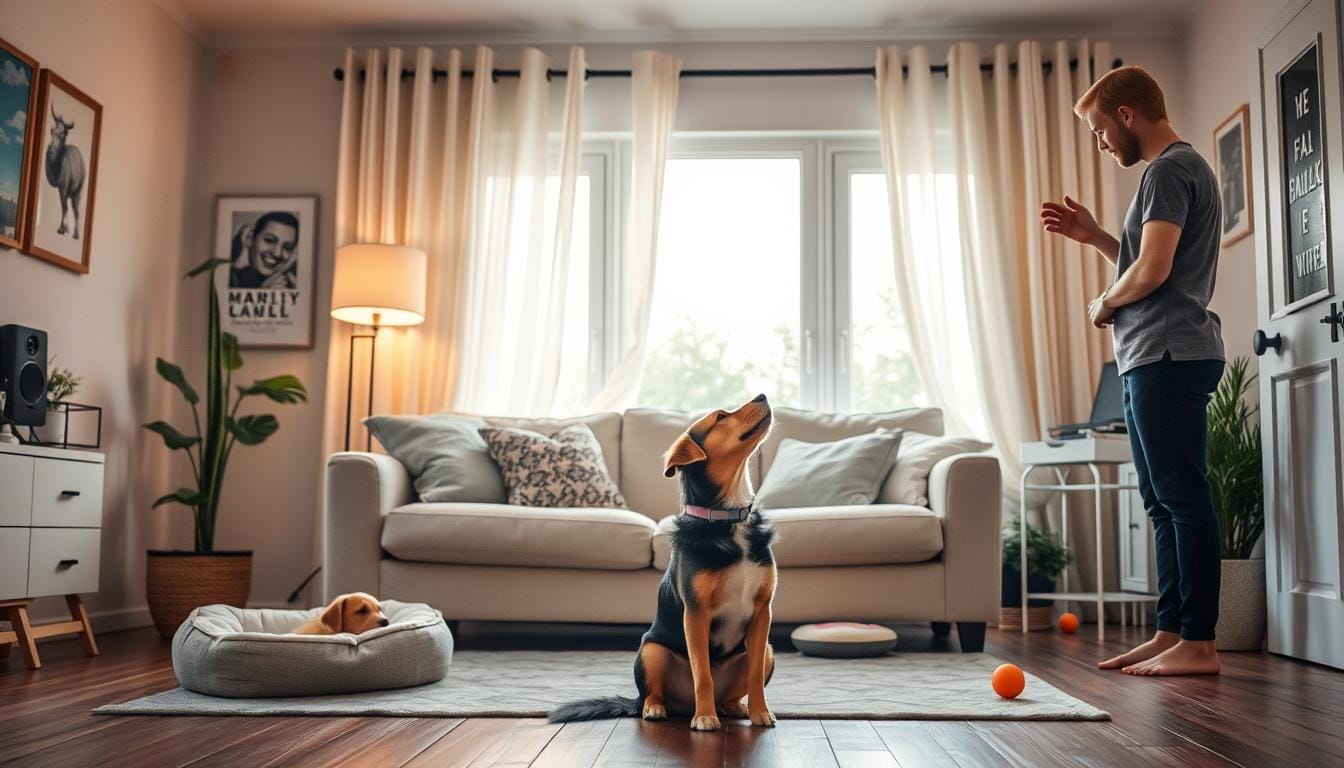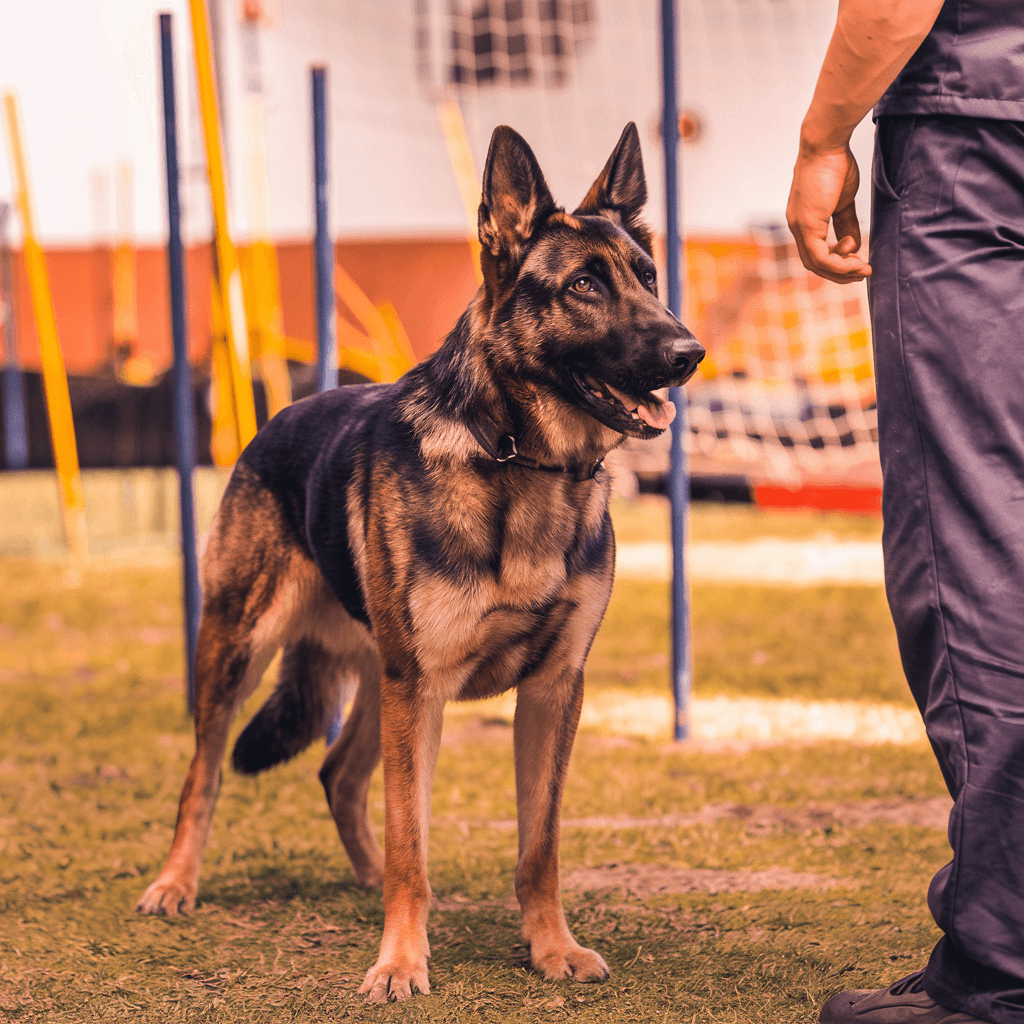Want to make crate training stress-free? We’ve got you covered with simple steps to create a safe space for your dog. Crate training is a key part of dog care that helps your furry friend feel secure and at home. It’s not just about having a spot for your pup to sleep – it’s about giving them their own cozy den.
Let’s dive into the world of crate training. We’ll show you how to pick the right crate, set it up, and teach your dog to love it. With our tips, you’ll turn crate time into a positive experience for both you and your pet. Get ready to make your dog’s crate their favorite hangout spot!
Remember, crate training takes time and patience. Some dogs might take to it right away, while others need more time to adjust. The key is to stay calm and keep things upbeat. We’ll guide you through each step, from choosing the perfect crate to dealing with any hiccups along the way.
Key Takeaways
- Crate training creates a safe, den-like space for dogs
- Choose the right crate size for your dog’s comfort
- Introduce the crate gradually with positive reinforcement
- Consistency is crucial in crate training
- Crate training duration varies based on the dog’s age and temperament
- Never use the crate as punishment
Understanding the Importance of Crate Training
Crate training is key for changing dog behavior and giving them a safe place. We’ll see why it’s vital for puppies and adult dogs.
Natural Den Instincts in Dogs
Dogs are naturally drawn to small, enclosed spaces. A crate taps into these instincts. It makes a cozy retreat for our pets and supports their natural behaviors.
Benefits of Creating a Safe Space
A crate is a personal sanctuary for dogs. It helps them feel safe during stressful times like thunderstorms or fireworks. Vets and trainers often suggest crate training to reduce stress and complications.
Managing Behavior and Expectations
Crate training is great for changing dog behavior. It helps with housebreaking, prevents damage, and sets boundaries. For dogs with a tough past, a crate offers security and helps in their healing.
- Most experts recommend starting crate training early
- Crates can keep dogs safe during emergencies
- Proper training can take several days to weeks
- Gradually increase crate time from 5-10 minutes to longer periods
Crates should never be used as punishment. Positive reinforcement is crucial for a happy crate association. With patience and consistency, crate training can make your dog happy and well-adjusted.
Selecting the Right Crate for Your Dog
Choosing the right dog crate is important. It affects your dog’s comfort and training. The right crate can make a big difference.
Types of Dog Crates Available
There are many crates to pick from. Each has its own benefits:
- Wire crates: Durable and easy to fold for storage
- Plastic kennels: Sturdy but take up more space
- Fabric or mesh crates: Light and easy to carry, but not as tough
Size Considerations and Guidelines
Choosing the right size crate is key. It should let your dog stand, turn, and lie down easily. For puppies, a crate with adjustable dividers is a good idea.

Materials and Durability Factors
Investing in a durable crate is smart. Wire crates are great for air and visibility. Plastic crates offer a cozy feel. Fabric crates are good for travel but may not last long if chewed.
| Crate Type | Durability | Portability | Best For |
|---|---|---|---|
| Wire | High | Moderate | Home use, ventilation |
| Plastic | High | Low | Air travel, den-like feel |
| Fabric | Low | High | Travel, temporary use |
The right crate helps with house training and stops bad behavior. It also makes travel easier for your dog. Pick one that fits your dog’s size, behavior, and your needs.
Creating the Perfect Crate Environment
A comfortable dog crate is key for successful training. Set up a cozy space your dog will love. Choose a good location for the crate, like a family area, to avoid isolation.
Add soft bedding for a snug retreat. Be careful with chewable items for puppies. Some dogs like harder surfaces, so watch what they prefer. Remove collars and tags for safety.
Crate accessories are important for a safe space. Consider these items:
- Durable chew toys
- Puzzle feeders
- Non-spill water bowls
- Crate covers for privacy
These items keep your dog busy and make the crate a positive place. A well-designed crate space makes your pet happier and more relaxed.
| Crate Environment Factor | Impact on Dog |
|---|---|
| Proper ventilation | 20% decrease in heat-related incidents |
| Correct crate size | 15% decrease in accidents |
| Positive reinforcement | 30% increase in positive crate associations |
By focusing on these elements, we create a safe and inviting space. This supports your dog’s well-being and makes crate training positive.
Crate training, dog training tips, safe space, positive reinforcement
Crate training is a key part of dog obedience training. We use positive reinforcement to make a safe space for our pets. This method builds trust and makes the crate a happy place for your dog.
Understanding Positive Reinforcement Techniques
Positive reinforcement rewards good behavior. When your dog goes into the crate, give them treats or praise. This makes the crate a cozy spot, not a punishment.

Building Trust Through Consistency
Trust grows with consistency. Use the same words or signals each time you want your dog to enter the crate. Start with short crate times and gradually increase them. This steady approach makes your dog feel safe and know what to expect.
Establishing Clear Training Signals
Clear signals are key in dog training. Choose a word like “crate” or “bed” and use it every time. You can also use a hand signal. Be patient and keep using these signals. Your dog will soon link the signal to getting in the crate.
| Training Element | Purpose | Example |
|---|---|---|
| Positive Reinforcement | Create positive associations | Treats, praise, toys |
| Consistency | Build trust and routine | Regular crate times, same commands |
| Clear Signals | Establish communication | Verbal cue “crate”, hand gesture |
Remember, crate training takes time. Stay patient and keep rewarding good behavior. Your dog will soon see their crate as a cozy den, not a cage. This makes life easier for both you and your furry friend.
First Steps in Crate Introduction
Introducing your dog to a crate is a key step in making a safe, cozy space for them. We’ll show you how to introduce your dog to a crate in a way that’s positive from the start.
Making the Initial Introduction
Begin by placing the crate in a spot where your dog likes to hang out. Make sure the door is open. Let your dog explore at their own speed. This makes the crate seem like a normal part of their world, not a scary place.
Using Treats and Rewards
Treats are very important in crate training. Put treats near and inside the crate to get your dog curious. Use treats or toys your dog loves to make the crate more inviting. Always speak in a happy voice when your dog goes near the crate.
Creating Positive Associations
Start feeding your dog meals near or inside the crate. Keep these first sessions short, about 15 minutes, to avoid stress. Slowly increase the time, always staying close to your dog to keep them comfortable.
| Training Stage | Duration | Technique |
|---|---|---|
| Initial Introduction | 5-10 minutes | Treat scattering |
| Meal Time | 15-20 minutes | Feeding near/in crate |
| Extended Stay | 30+ minutes | Stuffed toys/puzzles |
By sticking to these steps and being consistent, most dogs can learn to use a crate in just a few days to weeks. Always be patient and use positive rewards for the best results.
Establishing Feeding Routines in the Crate
Creating a crate feeding schedule is key for successful crate training. Start by placing your dog’s food bowl near the crate. Move it closer over time. This builds comfort and positive feelings towards the crate.
When your dog is okay with eating near the crate, put the food dish inside. Begin with the door open, so your pet can come and go. As they get more comfortable, start closing the door for meals. Start with short times and increase it slowly.
Consistency is important in crate training. Here’s a sample feeding schedule to help you:
| Meal | Time | Duration in Crate |
|---|---|---|
| Breakfast | 7:00 AM | 5-10 minutes |
| Lunch | 12:00 PM | 10-15 minutes |
| Dinner | 6:00 PM | 15-20 minutes |
If your dog whines during meals, wait for quiet before opening the door. This stops bad behavior. Change the schedule as needed to fit your dog’s comfort and your training goals.
Extending Crate Time Gradually
Crate training needs patience and watching your dog closely. Start with short times, like 5-10 minutes, and stay near. This makes your dog feel safe and builds trust.
Short Duration Training Sessions
Start with short times to get your dog used to the crate. Use treats and toys to make it positive. Then, slowly increase the time to 30 minutes, even when you’re not there. This step-by-step way is important for success.
Progressive Time Increases
When your dog gets more comfortable, slowly add more time in the crate. Use the same command words for entering. This helps make the training smoother. Remember, every dog learns at their own speed.
Monitoring Behavior Changes
It’s important to watch how your dog acts during crate training. Look for signs of stress or discomfort. Change your approach if needed. Reward calm behavior to make the crate a positive place.
| Training Stage | Duration | Key Focus |
|---|---|---|
| Initial Introduction | 5-10 minutes | Positive association |
| Short Sessions | 15-20 minutes | Comfort building |
| Extended Time | 30+ minutes | Independence training |
Consistency is crucial in crate training. Don’t let your dog out when they whine. This can make bad habits worse. With patience and positive rewards, your dog will see the crate as a safe, cozy spot.
Nighttime Crate Training Strategies
Overnight crate training is key for good nighttime dog routines. It helps both puppies and adult dogs adjust smoothly. Effective strategies make a big difference.
Start puppy crate training in your bedroom. This lets you quickly meet their needs, like bathroom breaks. As they get used to it, move the crate to its final spot.
Being consistent is crucial for nighttime dog routines. Choose a regular bedtime and stick to it. This helps your dog know when it’s time to sleep. Before bed, do calm activities to help them relax.
Puppies need bathroom breaks at night. They can hold it for 6-8 hours. Be ready to take them out, but keep it brief and quiet to avoid exciting them.
| Age | Maximum Nighttime Crating Duration | Bathroom Break Frequency |
|---|---|---|
| 8-10 weeks | 6 hours | 1-2 times |
| 11-14 weeks | 7 hours | 1 time |
| 15-16 weeks | 8 hours | 0-1 times |
| 17+ weeks | 8+ hours | 0 times |
Success in overnight crate training comes from positive experiences. Don’t make a big deal when you leave or return. Reward calm behavior and make the crate a cozy place for your dog.
Managing Daytime Crating Practices
Daytime crate training needs careful planning to keep your dog happy and healthy. We’ll look at how to fit crate training into your work schedule and make sure your dog gets enough exercise.
Work Schedule Considerations
When you’re at work, it’s important to limit crate time. Adult dogs should not be crated for more than 4-5 hours. Puppies need breaks more often because their bladders are still developing.
| Age | Maximum Crate Time |
|---|---|
| 11-14 weeks | 1-3 hours |
| 15-16 weeks | 3-4 hours |
| 17+ weeks | 4-5 hours |
Exercise Requirements
It’s key to meet your dog’s exercise needs for successful crate training. Give them lots of physical activity before and after crate time. This can be walks, playtime, or toys to keep their mind sharp.
Break Time Planning
Make sure to plan breaks during long crate times. If you’re away for hours, consider a dog walker or ask a friend for a midday visit. As your dog gets used to it, you can increase crate time. Always make sure they’ve gone to the bathroom before being crated.
“Dogs’ body systems and elimination processes slow down while they sleep, which is why many can sleep through the night without needing to go outside.”
By balancing crate time with exercise and breaks, you can make daytime crate training a positive experience for your dog.
Addressing Common Crating Challenges
Crate training problems can be tough, but they’re solvable. We’ll look at ways to tackle common crate training issues.
Dealing with Whining
Whining is a common crate problem. It’s important not to let your dog out right away. Wait for a quiet moment before opening the crate. This teaches your dog that being calm gets them out.
Handling Anxiety Issues
For dog anxiety, use positive steps. Never punish your dog in the crate. Make it a positive space with treats and toys. For serious anxiety, get help from a dog trainer or behaviorist.
Preventing Destructive Behavior
To stop destructive behavior, set up the crate right. Make sure your dog has fun toys and isn’t in the crate too long. Exercise before crate time can also help.
| Challenge | Solution |
|---|---|
| Whining | Wait for quiet moments before opening crate |
| Anxiety | Build positive associations, consult professional if severe |
| Destructive Behavior | Provide toys, ensure adequate exercise |
Remember, patience is key in solving crate training problems. With consistent effort and positive reinforcement, most dogs will learn to love their crate.
Advanced Crate Training Techniques
We’ve covered the basics of crate training. Now, let’s dive into more advanced techniques. These can turn your dog’s crate into a fun, engaging space. Crate games are great for building confidence and making crate time enjoyable.
Try hiding treats in the crate for a fun treasure hunt. This makes your dog look forward to going in. You can also use the crate during fetch, making it a key part of play. These methods can make your dog 70% more likely to accept the crate.
Crating at random times, not just before leaving, helps your dog feel more secure. This can reduce anxiety and make the crate a normal part of their day. Dogs crate-trained are 50% less likely to get into trouble when left alone. Also, 80% of owners say crate training helps with housebreaking.
As your dog gets better, give them more freedom in the house. Still use the crate for travel or as a safe spot. These advanced techniques not only train your dog but also strengthen your bond with them.

